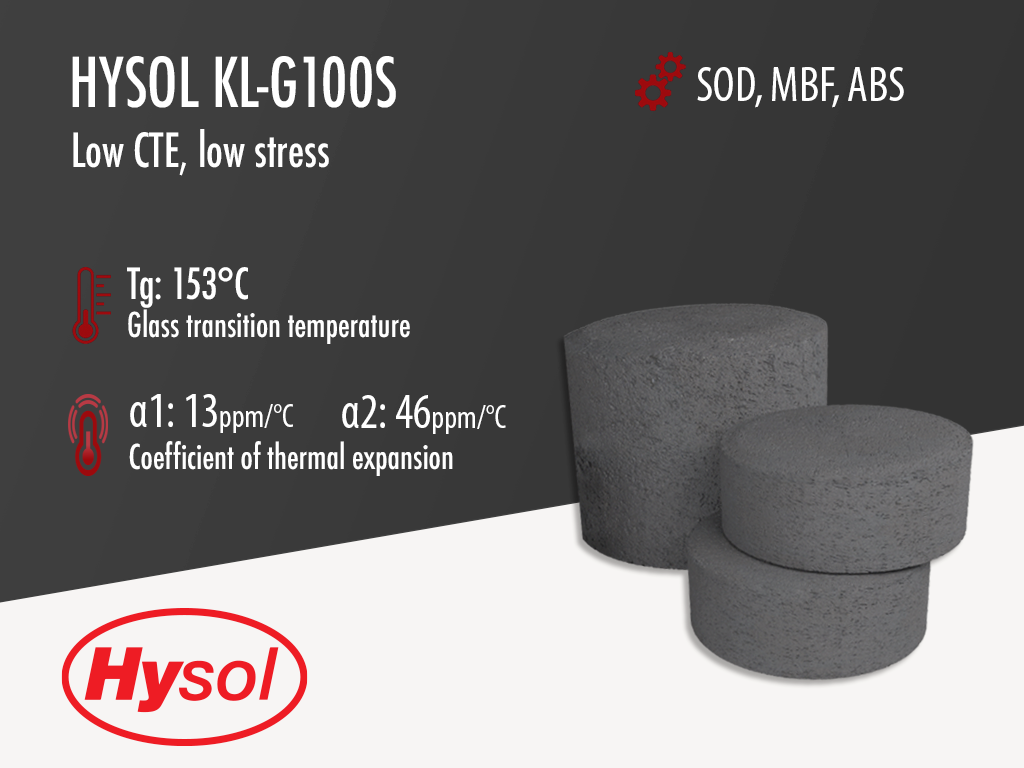Hysol KL-G100S | Black Epoxy Mold Compound
Harmonization Code : 3907.30.00.90 | Polyacetals, other polyethers and epoxide resins, in primary forms; polycarbonates, alkyd resins, polyallyl esters and other polyesters, in primary forms : Epoxide resins : Other
Main features
- Low CTE (13 ppm/°C)
- Low stress
- For SOD, MBF, ABS packages
Product Description
Hysol KL-G100S is a black, semiconductor grade, high productivity molding compound, providing a wide operation window. It is 80% filled with spherical/fused silica and achieves a flammability rating of V0 at UL94 testing conditions.
Hysol KL-G100S is an environmentally friendly molding compound with high moldability that has a low coefficient of thermal expansion (13ppm/°C). It is typically used for SOD, MBF and ABS semiconductor packages. Its CTI, comparative tracking index value is 525V.
Technical Specifications
| General Properties | |||||||||||
| Color Color The color | Black | ||||||||||
| Filler Content | 80 % | ||||||||||
| Specific Gravity Specific Gravity Specific gravity (SG) is the ratio of the density of a substance to the density of a reference substance; equivalently, it is the ratio of the mass of a substance to the mass of a reference substance for the same given volume. For liquids, the reference substance is almost always water (1), while for gases, it is air (1.18) at room temperature. Specific gravity is unitless. | 1.89 | ||||||||||
| |||||||||||
| Chemical Properties | |||||||||||
| Moisture absorption | 0.40 % | ||||||||||
| |||||||||||
| Physical Properties | |||||||||||
| Spiral Flow @ 175°C | 91.4 cm | ||||||||||
| Thermal Properties | |||||||||||
| Glass Transition Temperature (Tg) Glass Transition Temperature (Tg) The glass transition temperature for organic adhesives is a temperature region where the polymers change from glassy and brittle to soft and rubbery. Increasing the temperature further continues the softening process as the viscosity drops too. Temperatures between the glass transition temperature and below the decomposition point of the adhesive are the best region for bonding. The glass-transition temperature Tg of a material characterizes the range of temperatures over which this glass transition occurs. | 153 °C | ||||||||||
| Thermal Conductivity Thermal Conductivity Thermal conductivity describes the ability of a material to conduct heat. It is required by power packages in order to dissipate heat and maintain stable electrical performance. Thermal conductivity units are [W/(m K)] in the SI system and [Btu/(hr ft °F)] in the Imperial system. | 0.74-1.07 W/m.K | ||||||||||
| UL 94 Rating UL 94 Rating Flammability rating classification. It determines how fast a material burns or extinguishes once it is ignited. HB: slow burning on a horizontal specimen; burning rate less than 76 mm/min for thickness less than 3 mm or burning stops before 100 mm V-2: burning stops within 30 seconds on a vertical specimen; drips of flaming particles are allowed. V-1: burning stops within 30 seconds on a vertical specimen; drips of particles allowed as long as they are not inflamed. V-0: burning stops within 10 seconds on a vertical specimen; drips of particles allowed as long as they are not inflamed. 5VB: burning stops within 60 seconds on a vertical specimen; no drips allowed; plaque specimens may develop a hole. 5VA: burning stops within 60 seconds on a vertical specimen; no drips allowed; plaque specimens may not develop a hole | V0 | ||||||||||
| |||||||||||
| |||||||||||
| Electrical Properties | |||||||||||
| |||||||||||
| Mechanical Properties | |||||||||||
| Molded Shrinkage | 0.25 % | ||||||||||
| |||||||||||
| Curing Conditions | |||||||||||
| Transfer Pressure | 40 - 70 kg/cm2 | ||||||||||
| Transfer Time | 10 - 25 s | ||||||||||
| |||||||||||
| |||||||||||
Additional Information
Additional Technical Information
| Property | Unit | Temperature | ||
| 25℃ | 150℃ | 175℃ | ||
| Chlorine (Cl⁻) | ppm | 15 | ||
| Sodium (Na⁺) | ppm | 4 | ||
| Potassium (K⁺) | ppm | 1 | ||
| Bromine (Br⁻) | ppm | 0 | ||
| Sulfate (SO₄²⁻) | ppm | 1 | ||
| Electrical Conductivity (oEW) | uS/cm | 20 | - | - |
| Flexural Strength | MPa | 145 | 91 | 61 |
| Flexural Modulus | MPa | 12,577 | 612 | 501 |
| Adhesion Strength to Cu (Post-PMC) | MPa | 0.90 | 1.14 | 1.02 |
| Adhesion Strength to Cu (Post-MSL3) | MPa | 0.40 | 0.17 | 0.12 |



